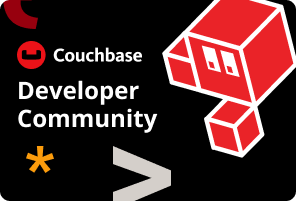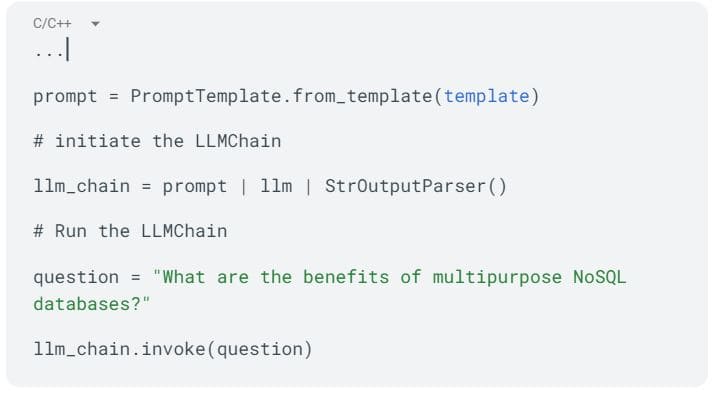LangChain 개요
LangChain은 개발자에게 다음과 같은 애플리케이션을 만드는 데 필수적인 도구를 제공하도록 설계된 강력한 플랫폼입니다. 대규모 언어 모델(LLM). LLM 작업과 관련된 복잡한 프로세스를 간소화하여 챗봇, 콘텐츠 생성기, 자동화된 텍스트 프로세서와 같은 정교한 애플리케이션을 개발할 수 있습니다.
LangChain은 애플리케이션 개발자가 대규모 언어 모델을 훨씬 쉽게 통합하고 배포할 수 있는 강력하고 유연한 프레임워크를 제공합니다. 특히 모델 관리 및 데이터 처리의 복잡성 없이 LLM 기능을 활용하고자 하는 개발자에게 유용합니다.
이 가이드에서는 LangChain의 작동 방식, 주요 구성 요소와 기능, 실제 사용 사례, 이점에 대해 다룹니다. 또한 LangChain을 시작하는 방법에 대한 지침을 제공하고, Couchbase와의 통합에 대해 설명하며, 추가 리소스를 통해 핵심 사항을 요약합니다. 마지막으로, 자주 묻는 질문을 통해 LangChain에 대한 포괄적인 이해를 돕고자 합니다.
- LangChain은 어떻게 작동하나요?
- LangChain의 구성 요소
- LangChain 사용 사례
- LangChain 혜택
- LangChain을 시작하는 방법
- 카우치베이스 랭체인 통합
- 주요 요점 및 추가 리소스
- 자주 묻는 질문
LangChain은 어떻게 작동하나요?
LangChain은 개발자를 위한 사용자 친화적인 프레임워크를 제공하여 대규모 언어 모델 작업 프로세스를 간소화합니다. 예를 들어, 개발자가 전자상거래 추천 시스템은 LangChain을 사용하여 OpenAI의 GPT-4 및 Anthropic의 Claude와 같은 다양한 대규모 언어 모델을 통합할 수 있습니다.
추천 시스템은 LangChain의 커넥터를 사용하여 다음과 같은 여러 소스의 데이터에 원활하게 액세스할 수 있습니다:
- 문서 데이터베이스: 카우치베이스 또는 몽고DB에 연결하여 가져오기 제품 카탈로그 및 사용자 활동 데이터.
- 데이터베이스 시스템: 주문 내역 및 거래 기록을 위해 MySQL 또는 PostgreSQL과 같은 SQL 데이터베이스와 통합하세요.
- API: 실시간 재고 및 판매 데이터를 위해 Shopify 또는 WooCommerce와 같은 이커머스 플랫폼에서 데이터를 가져옵니다.
- 클라우드 스토리지: AWS S3 또는 Google 클라우드 스토리지와 같은 클라우드 서비스에 저장된 사용자 생성 콘텐츠에 액세스하여 개인화된 추천을 받을 수 있습니다.
- 하이브리드 검색: Elasticsearch 또는 Solr을 활용하여 하이브리드 검색 키워드 검색과 벡터 기반 시맨틱 검색 를 사용하여 검색 결과의 정확성과 관련성을 향상시킵니다.
이러한 원활한 통합을 통해 추천 시스템은 다양한 소스에서 관련 데이터를 손쉽게 가져와 사용자에게 개인화되고 정확한 상품 추천을 제공할 수 있습니다.
또한, LangChain은 여러 LLM을 지원하므로 개발자는 자연어 추천을 생성하는 데 GPT-4를, 사용자 행동 패턴을 분석하는 데 Claude를 활용할 수 있습니다. 개발자는 각 모델의 강점과 하이브리드 검색의 힘을 활용하여 추천 시스템이 관련성이 높고 시의적절한 상품 제안을 제공함으로써 사용자 쇼핑 경험을 향상시키고 매출을 높일 수 있습니다.
LangChain의 구성 요소
LangChain의 아키텍처는 LLM 애플리케이션 개발을 용이하게 하는 몇 가지 필수 구성 요소로 이루어져 있습니다. 이러한 구성 요소를 활용함으로써 LangChain은 고급 LLM 기반 애플리케이션을 구축하고 배포하는 프로세스를 간소화합니다:
- 데이터 커넥터: 이를 통해 다양한 데이터 소스와의 통합이 가능해져 데이터베이스에서 데이터를 원활하게 수집하고 처리할 수 있습니다, API및 클라우드 스토리지.
- 모델 통합: LangChain은 GPT-4 및 BERT와 같은 인기 모델을 포함한 여러 LLM을 지원하므로 개발자는 자신의 필요에 가장 적합한 것을 선택할 수 있습니다.
- 처리 파이프라인: 이러한 도구는 데이터 정리, 변환, 모델 훈련과 같은 작업을 위한 워크플로를 만들고 관리하여 효율적인 데이터 처리 및 준비를 보장합니다.
- 배포 모듈: LangChain은 애플리케이션 배포를 자동화하고, 프로덕션 환경에서 확장 및 유지 관리를 간소화하는 도구를 제공합니다.
- 모니터링 및 로깅: 이 플랫폼은 애플리케이션 성능에 대한 인사이트를 제공하는 실시간 모니터링 및 로깅 도구를 제공하여 원활하고 효율적인 운영을 보장합니다.
LangChain 기능
LangChain은 LLM 애플리케이션을 원활하고 효율적으로 개발 및 배포할 수 있도록 설계된 다양한 기능을 갖추고 있습니다. 여러 언어 모델을 지원하여 프로젝트에 가장 적합한 모델을 선택할 수 있는 유연성을 제공합니다. 플랫폼의 유연한 데이터 통합 기능을 통해 다양한 데이터 소스에 쉽게 연결할 수 있어 애플리케이션 내에서 원활한 데이터 흐름을 보장합니다.
LangChain의 강력한 파이프라인 관리 도구는 복잡한 데이터 처리 워크플로우의 생성 및 관리를 용이하게 하여 데이터 정리 및 변환과 같은 작업을 효율적으로 처리할 수 있도록 지원합니다.
랭체인 표현 언어(LCEL) 을 사용하면 다양한 컴포넌트와 체인을 쉽게 구성할 수 있습니다: "LCEL은 첫날부터 가장 간단한 "프롬프트 + LLM" 체인부터 가장 복잡한 체인까지 코드 변경 없이 프로토타입을 생산에 투입할 수 있도록 설계되었습니다(100개의 단계로 구성된 LCEL 체인을 생산에서 성공적으로 실행하는 사람들을 보았습니다)."
자동화된 배포 기능으로 애플리케이션을 프로덕션 환경에 간편하게 도입할 수 있어 확장 및 유지 관리가 쉬워집니다. 또한 이 플랫폼은 확장성을 고려하여 설계되어 애플리케이션이 증가하는 데이터와 사용자 상호 작용을 처리할 수 있습니다. 실시간 모니터링 도구는 애플리케이션 성능에 대한 귀중한 인사이트를 제공하여 효율성을 최적화하고 유지하는 데 도움을 줍니다.
LangChain 코드 예시
프레임워크의 단순성을 설명하기 위해, 다음은 LangChain의 파이프라인이 여러 단계를 어떻게 연결하는지 보여주는 짧은 코드 스니펫입니다:
LangChain 사용 사례
LangChain의 다재다능함으로 인해 다양한 시나리오에 적용할 수 있습니다. 특히 자연어로 사용자 쿼리를 이해하고 응답할 수 있는 챗봇과 대화형 에이전트를 생성하여 고객 상호 작용과 지원을 향상시키는 데 효과적입니다.
다른 주목할 만한 사용 사례는 다음과 같습니다:
- 콘텐츠 생성: 블로그, 기사, 마케팅 자료를 위한 고품질 콘텐츠 제작을 자동화하여 콘텐츠 제작에 필요한 시간과 노력을 크게 줄일 수 있습니다.
- 감정 분석: 텍스트 데이터를 분석하여 고객의 감정을 측정하고 비즈니스 의사결정에 정보를 제공합니다.
- 문서 요약: 대용량 문서에서 핵심 정보를 빠르게 추출하여 효율적으로 정보를 검색할 수 있습니다.
- 언어 번역: 다국어 지원 시스템을 만드는 데 이상적인 서로 다른 언어 간의 텍스트를 실시간으로 번역하는 애플리케이션을 개발하세요.
- 고객 지원 자동화: 고객 문의 및 지원 티켓을 자동으로 처리하는 시스템을 만들어 응답 시간과 고객 만족도를 개선하세요.
LangChain 혜택
LangChain을 채택하면 개발자와 조직에게 매력적인 선택이 될 수 있는 다양한 이점이 있습니다. 주요 이점 중 하나는 개발 간소화입니다. LangChain은 대규모 언어 모델 작업의 복잡성을 추상화하여 더 빠르고 쉽게 개발할 수 있게 해줍니다. 이는 LLM 애플리케이션을 구축하고 유지하는 데 필요한 시간과 리소스를 줄여주기 때문에 비용 효율성으로 이어집니다.
또한 LangChain은 향상된 유연성을 제공하여 다양한 모델과 데이터 소스를 지원하므로 특정 요구사항을 충족하는 맞춤형 솔루션을 만들 수 있습니다. 플랫폼의 확장성을 통해 애플리케이션은 증가하는 데이터와 사용자 상호 작용을 처리할 수 있으므로 비즈니스 요구사항에 따라 애플리케이션을 확장할 수 있습니다. 모니터링 및 최적화를 위한 기본 제공 도구는 애플리케이션의 효율적인 실행을 보장하여 성능 향상을 이끌어냅니다.
또한 LangChain의 간소화된 개발 및 배포 프로세스는 애플리케이션의 신속한 제공을 촉진하여 경쟁 우위를 제공합니다.
LangChain을 시작하는 방법
시작하려면 LangChain 문서 에서 자세한 가이드와 예시를 확인하세요. 필요한 LangChain 모듈 설치 를 읽었다면 코드를 작성할 준비가 된 것입니다. 이 문서에서는 언어 모델 설정, 데이터 소스 연결, 파이프라인 구성 등 다양한 주제를 다루고 있습니다.
간단한 파이프라인을 만드는 방법을 이해하기 위해 기본 예제를 살펴보는 것부터 시작하세요. 또한, 문서에서는 API 참조와 고급 사용 시나리오를 제공하여 특정 요구사항에 맞게 LangChain의 모든 기능을 활용할 수 있도록 도와줍니다. SDK와 설명서를 통해 확장 가능한 AI 애플리케이션을 빠르게 빌드하고 배포할 수 있습니다.
카우치베이스 랭체인 통합
LangChain은 고성능 NoSQL 데이터베이스인 Couchbase와 원활하게 통합되어 대량의 데이터 처리 및 처리를 향상시킵니다. 이러한 통합을 통해 개발자는 Couchbase의 강력한 기능을 활용할 수 있습니다. 데이터 관리 기능을 통해 데이터를 효율적으로 저장하고 관리할 수 있으며, 이를 통해 LangChain 애플리케이션에서 액세스하고 처리할 수 있습니다.
랭체인과 카우치베이스의 결합은 특히 빠른 속도가 필요한 애플리케이션에 유용합니다. 데이터 검색 및 실시간 처리챗봇 및 추천 시스템과 같은 애플리케이션을 지원합니다. Couchbase의 확장 가능한 데이터 관리를 통해 대규모 데이터 세트를 효율적으로 처리할 수 있으며, 실시간 데이터 액세스를 통해 반응형 애플리케이션을 위해 데이터를 신속하게 검색하고 처리할 수 있습니다. 또한 이러한 통합은 성능 향상에 기여하며, Couchbase의 높은 처리량과 짧은 지연 시간은 애플리케이션의 전반적인 효율성을 향상시킵니다.
주요 요점 및 추가 리소스
요약하자면, LangChain은 대규모 언어 모델을 사용하여 애플리케이션 개발을 간소화하는 다재다능하고 강력한 플랫폼입니다. 통합 환경과 강력한 기능으로 확장 가능하고 효율적인 솔루션을 구축하고자 하는 개발자에게 이상적인 선택입니다. 데이터 연결, 모델 통합 및 배포를 위한 LangChain의 도구는 개발 프로세스를 간소화하여 애플리케이션을 빠르고 쉽게 생성할 수 있도록 합니다.
LangChain을 시작하려면 공식 웹사이트에 가입하고 사용 가능한 문서와 튜토리얼을 살펴보세요. 추가 리소스를 보려면 다음 링크를 참조하세요:
이러한 리소스는 LangChain 작업을 시작할 때 유용한 정보와 지원을 제공합니다. LLM 및 AI와 관련된 개념에 대해 자세히 알아보려면 다음을 방문하세요. 블로그 그리고 개념 허브.
자주 묻는 질문
랭체인의 목적은 무엇인가요?
LangChain은 대규모 언어 모델을 사용하는 애플리케이션 개발을 간소화할 수 있는 응집력 있고 유연한 프레임워크를 제공합니다.
LangChain은 어디에 사용되나요?
LangChain은 대규모 언어 모델의 힘을 활용하여 챗봇, 콘텐츠 생성 도구, 감정 분석 시스템 등과 같은 애플리케이션을 개발하는 데 사용됩니다.
랭체인 에이전트란 무엇인가요?
랭체인 에이전트는 주어진 목표를 달성하기 위해 데이터 쿼리, 텍스트 처리, 다른 서비스와의 상호작용 등 특정 작업을 수행하는 플랫폼 내의 자율적인 구성 요소입니다.
랑체인과 라마인덱스의 차이점은 무엇인가요?
LangChain은 대규모 언어 모델을 통합하고 배포하기 위한 포괄적인 플랫폼을 제공하는 데 중점을 두는 반면, LlamaIndex는 대규모 텍스트 데이터의 색인 및 검색에 더 중점을 둡니다.

